The OnePlus 7 Pro Review: Outstanding Performance & Screen, Adequate Everything Else
by Andrei Frumusanu on June 19, 2019 12:00 PM EST- Posted in
- Mobile
- Smartphones
- OnePlus
- OnePlus 7 Pro
System Performance
One of the key aspects of the new OnePlus 7 Pro is its promised performance. OnePlus now for a few generations has made a large focus on the performance of their devices, opting to go the extra mile to optimise the software experience of their devices and the OS software. The new 7 Pro promises to thus to differentiate itself from other Snapdragon 855 devices.
Another way that the performance of the OnePlus 7 Pro should be much improved compared to the competition is the inclusion of UFS 3.0 storage as well as the new 90Hz display. Admittedly our testing setup for NAND is currently inadequate to fully test the storage speed, however the 90Hz refresh rate does have some immediate effects on some benchmarks, in particular our favourite, PCMark.
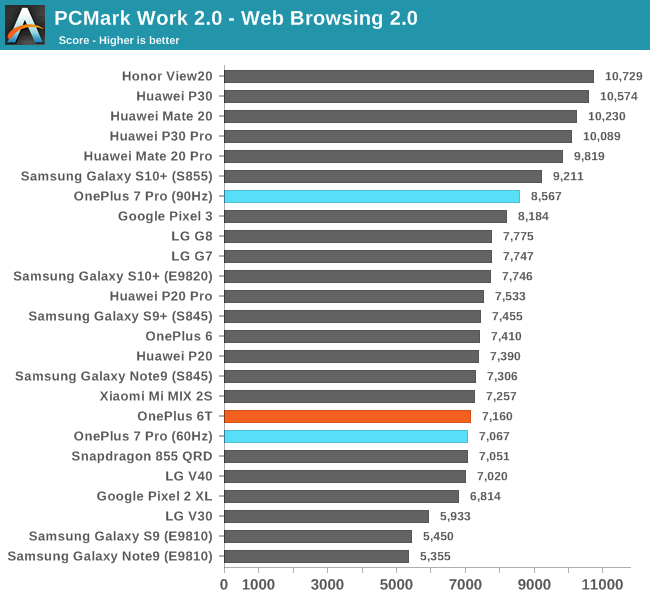
In PCMark’s web browsing test, the OnePlus 7 Pro showcases some larger score discrepancy between its 60 and 90Hz modes. What is interesting is that the 60Hz score is unusually low, performing quite a lot worse than what we saw from other Snapdragon 855 devices who are 60Hz themselves as well. The 90Hz mode does up the score notably, however it still slightly lags behind the Galaxy S10+ as well as all other Kirin 980 powered devices.
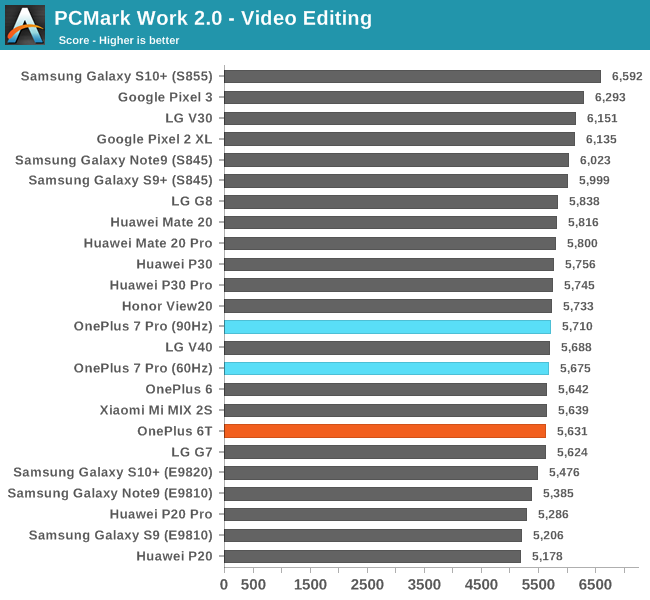
The video editing score is in line with the majority of the pack, but again the OP7Pro is lagging behind the Samsung S10+ with the Snapdragon 855.
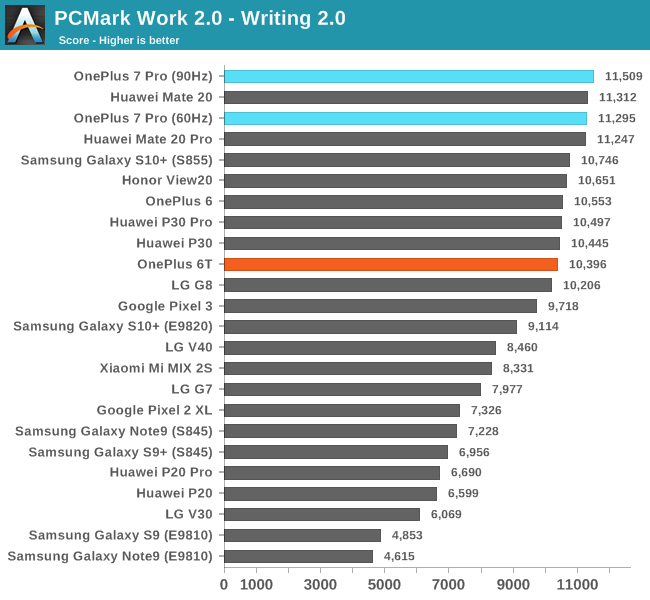
It’s in the writing sub-test, arguably the single most important workload of PCMark where the OnePlus 7 Pro manages to distinguish itself more compared to other devices. Here both in 60 and 90Hz modes the device manages to take the top spots in the charts.
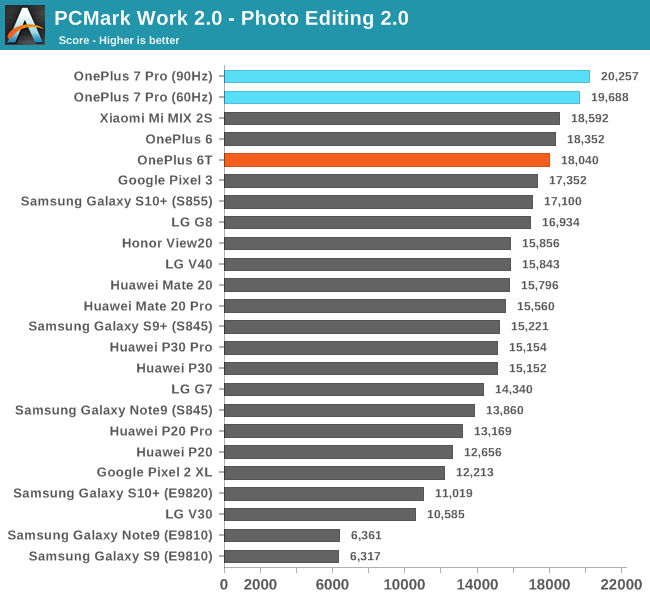
The photo editing workload is also an important indicator of general device snappiness. Here the OP7Pro again beats the competition from Samsung and LG with the same SoC. I think it’s possible that OnePlus has better and more optimised OS libraries and this is why this is seen as a performance advantage compared to the competition.
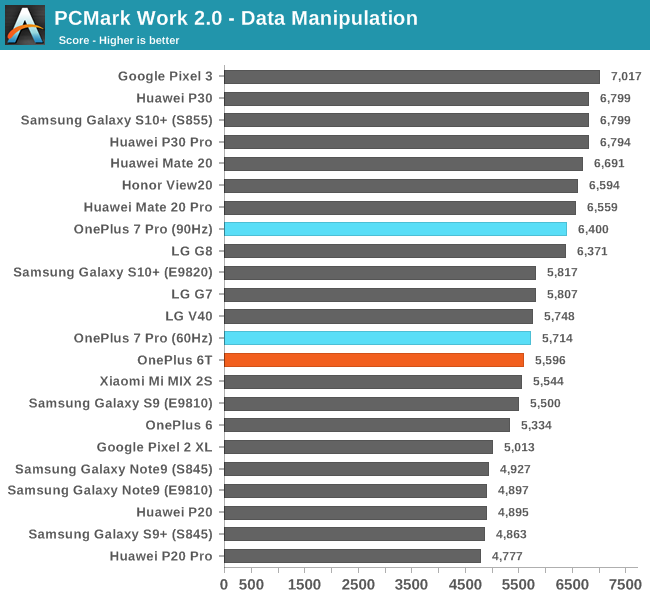
The data manipulation score again has a notable difference between the 90Hz and 60Hz modes, but much like the web-browsing test we’re again seeing some oddly low performance of the 60Hz mode, much below that of other Snapdragon 855 devices.
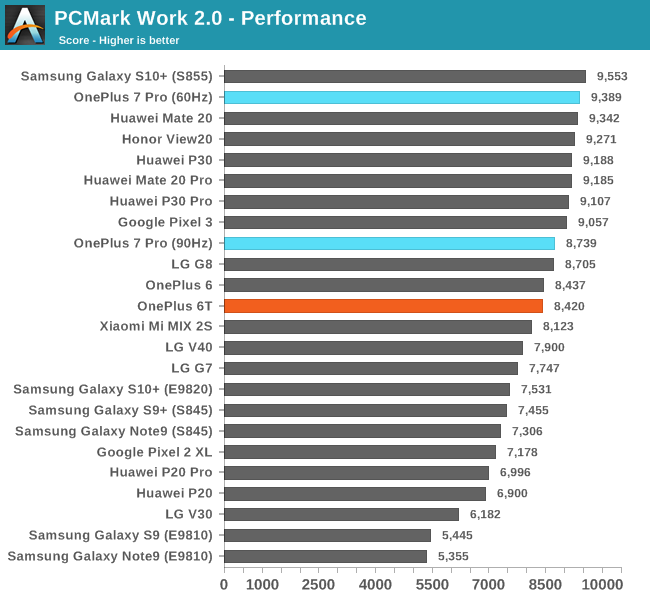
Finally the end-score of the OnePlus 7 Pro ends up just shy of the Snapdragon Galaxy S10+, losing some yet winning others. The 60Hz mode does have an effect of the score and in this mode the OP7Pro loses a few hundred points.
Browser JS Benchmarks
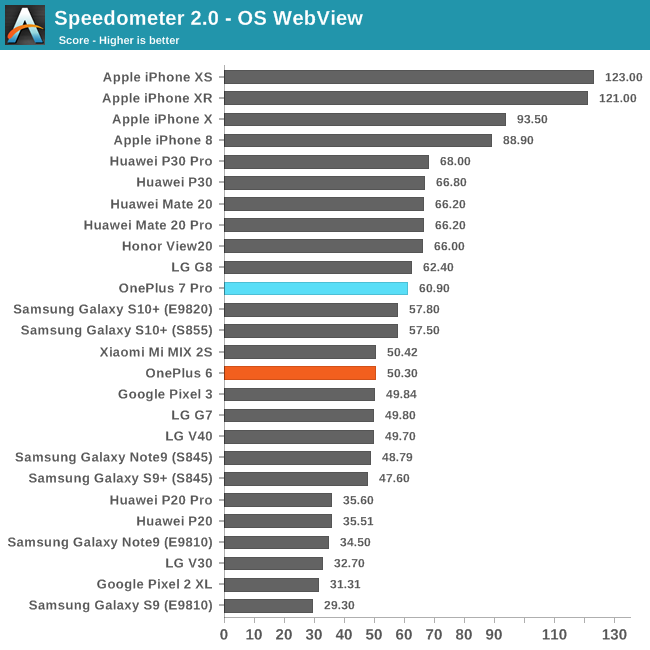

In the Javascript web-browsing benchmarks the OP7Pro is relatively in line with the LG G8. The odd thing here again is that Samsung’s Galaxy S10+ with the same chip offers a quite different performance fingerprint. This is particularly visible in WebXPRT where it has a lead over the OP7Pro. It’s to be noted that in the web benchmarks I haven’t seen any difference in scoring whether the device was in 60 or 90Hz display modes.
Device Performance Conclusion – A Lot Not Covered By Benchmarks
While the OP7Pro performed quite well in our system benchmark suite, there’s a few aspects of the phone that unfortunately aren’t really covered. One such things is the NAND storage and the experience that the 90Hz mode gives.
In terms of the new UFS 3.0 storage, its addition to the phone was something that I immediately noticed in regards to application installation speeds. Here the OP7Pro was significantly faster than any other Android device I’ve had before, shaving off significant chunks off of installation times.
Another subjective aspect that is hard to objectively convey in benchmark numbers is simply the vastly improved UI fluidity brought forth by the 90Hz refresh rate of the phone. Any PC user with a higher refresh rate monitor will know what an immense difference this makes compared to the more traditional 60Hz. The very first time I held the OP7Pro at our pre-briefing I immediately saw the massive difference this makes to the fluidity of scrolling and very much knew that this would be the killer feature of the phone, no matter how all other aspects would end up.
While in terms of UI snappiness, the OnePlus 7 Pro isn’t any faster than say Samsung’s S10, its fluidity just stands out as something beyond any other current device (Asus Rog Phone & Razer phones aside). OnePlus’ combination of high-refresh rate on an OLED screen makes for an incredible selling point.
While the 90Hz is fantastic, I have some serious doubts about the 60Hz mode of the phone and whatever OnePlus did to the software stack in terms of implementing this. For some odd reason, it makes things notably slower, and I’m not just talking about simply there being less frames, but actual reduced responsiveness and an impression of more sluggishness and jank. In fact, in 60Hz mode the phone feels notably more sluggish than the Galaxy S10, when in theory it should have been equal. The fact that the OnePlus 7 Pro somewhat performs more similar to the G8 in some web benchmarks has me suspect it actually has similar BSP performance issues, and the 90Hz mode somehow just counter-acts these negatives. It’s really odd.
That being said, just stick with the 90Hz mode and you’ll have a fantastic experience beyond that of any other phone out in the market right now.










91 Comments
View All Comments
hadrons - Wednesday, June 19, 2019 - link
Currently great camera is a huge factor for premium phones and one plus has not been up to the big players for a long time, but still somehow people rate this phone better than a pixel phone. Every other Android manufacturers either lag behind or totally behind security or software updates and one plus is one among them. On a daily end user level scale, one plus is only as fast as the SOC and the Android version in it. Price is the only factor that I find some advantage in buying one plus.1_rick - Wednesday, June 19, 2019 - link
Not only that, but $670 for the base model (I'm only considering the Pro as you "can't get" the 7 in the US) is hardly a "flagship killer". That honor would more properly belong to something like the Xiaomi Mi Mix 3, at $470 on AliExpress.MrSpadge - Wednesday, June 19, 2019 - link
... or the Mi9, starting at 400€ in Germany (equivalent to ~400$ in the US).ilaicohen - Saturday, July 27, 2019 - link
Wth guys you can just download the Gcam and there you go, a better camera. And just saying, the camera isn't as bad as everyone says. Actually, it's pretty great. And about the price, it's half the price of the iPhone XS Max (with tax) so yea. It's a flagship killer. So cut off the bullshyt and go get yourself a OnePlus 7 Pro.badbanana - Tuesday, June 25, 2019 - link
i don't get this "..should have a better camera" thing. most users can't even tell what "f/2.0 lens" mean. for me, as long as it takes a clear photo, without the shakes then it's a "better" camera.i've owned every Samsung (for once never got any software updates) flagship since the S3 came out and found that OnePlus gets software updates whenever it's available.
systemBuilder - Friday, July 19, 2019 - link
I have a OnePlus 6T. The camera beats and iPhone 6S in dxomark. For me, that's "Good Enough". Freaking out over a compromise camera (cellphone cameras are ALWAYS compromise cameras) just shows that the reviewer has no perspective on life. I enjoy the on-screen fingerprint reader, the fantastic battery life, and the generous RAM & Flash Storage and the OLED screen, all at a great price.johansyren - Tuesday, November 10, 2020 - link
As someone who switched from a wireless charging phone to a OnePlus with insanely fast Dash charging, I genuinely prefer the later. I just don’t have to worry about charging my phone anymore. I’ve been on this phone for 1.5 years now and I’m still in awe every time I charge it because of it’s speed.
I read about it at https://casinovalley.ca/best-picks/best-gambling-p...
Most of the time I plug it in when I’m getting ready to head out and in 10 minutes it charges up to a point that I don’t need to worry about battery throughout the day. Wireless charging would be a nice bonus, but considering how slow it used to be comparatively, I’d still never actually use it.
Roy2002 - Wednesday, June 19, 2019 - link
It is a great phone, wish it has better cameras.XabanakFanatik - Wednesday, June 19, 2019 - link
No mention of the terrible stuttering when the phone is in 90Hz mode and you play a 60FPS video? OnePlus claims the display's refresh rate is adaptive to the content yet it cannot smoothly "adapt" to play a 60FPS video.By far the biggest complaint I have with the phone - If I want to watch a 60FPS video without terrible stutter, I have to go to the options and switch the display to 60Hz mode before, then switch it back to 90Hz mode after.
Xinn3r - Wednesday, June 19, 2019 - link
Now that's a deal breaker